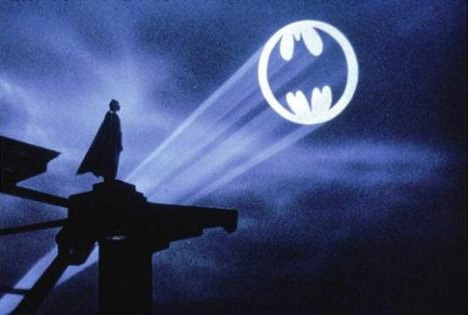Riddle me this: what is 75 years of age but never gets old? In 1939, the year the Second World War officially began, artist Bob Kane and writer Bill Finger created a fictional comic-book character that would evolve and endure for far longer than either of them could’ve possibly imagined.
First appearing in Detective Comics #27 in May 1939, that character would become one of the most iconic fictional characters in popular culture for seven and a half decades (and counting).
Not bad going for a caped crime fighter who looked a bit silly in the first instance. These are 10 Things (Among Many) To Be Grateful to the Dark Knight For…
The 75th anniversary year of the Caped Crusader will no doubt be marked by various offerings at DC Comics. With the Batman/Superman Dawn of Justice movie in the works and being constantly talked about and the new Gotham television series it is fair to say the Batman legacy is as strong as it’s ever been in those 75 years since it began.
It is difficult to think of a comic-book creation or franchise that has endured so long and spawned so much popular content across all mediums; DC’s other flagship creation Superman would be the closest contender, but Superman hasn’t spawned quite so rich a cross-media canon as the Dark Knight has. Even for those who don’t (and might never) read the comics, so much of the Batman mythology is immediately familiar to them; from Robin and Two-Face to the Batmobile and Alfred the Butler, from the classic theme-tune of the sixties Adam West show to the sight of the Bat Signal shining out over Gotham City (who hasn’t at some point looked at a night-time skyline and imagined seeing the Bat Signal projecting out over the city?), and much else besides.
Only Star Wars and Star Trek can boast that degree of penetration into popular consciousness (in as much as people who’ve never even seen Star Trek or Star Wars nevertheless find themselves involuntarily knowing a great many of the icons, aspects and idiosyncrasies of those fictional worlds just because of the sheer degree of cultural penetration; just as with Batman and Gotham City).
As a comic-book enthusiast, one thing that has always been particularly interesting to me just how many great, enduring and iconic villains have come from the pages of Batman comics, as compared to other comic-book titles. The same can’t be said of Superman, for example, or Captain America or Iron Man, to name just a few.

While some franchises like X-Men or Spiderman also lay claim to an impressive pantheon of villains, those characters aren’t cross-medium in the same way as Batman’s Rogues Gallery is; again the point being that many, many people who don’t even read comics will know perfectly well who The Joker is, who Catwoman is, along with The Riddler, Two-Face, Penguin, Bane, Poison Ivy, Harley Quinn, and several others.
Not only know who they are, but know what they look like and probably know a little bit about them. That’s a degree of cultural penetration that isn’t equaled by other comic-book mythologies.
I’ve always marveled at the list of legendary villains in the Batman mythology: and the more I think about it, the more I think it’s this pantheon of villains – more than anything else, including the Dark Knight himself – that imparts the Batman mythology its elevated status and makes it so enduringly popular.
In any case, here are 10 Things I am personally grateful to the Batman mythology for giving us. The list could be bigger than 10 in all likelihood, but I’m lazy…
Tim Burton’s Films
1989’s Batman and 1992’s Batman Returns specifically; both terrific films and almost a decade before the first X-Men film set the modern standard for comic-book adaptations in cinema. At the time, these films certainly left the Superman film franchise looking quaint and silly, while the inimitable Burton’s two takes on the Dark Knight’s world stand up remarkably well now too and are more than a match for modern comic-book movie adaptations (possibly better, some would argue too).
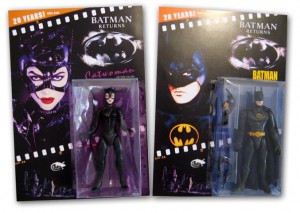
Burton’s gothic vision of Gotham City is still the vision that most defines a lot of people’s sense of Batman, for many people more so than the Gotham of Christopher Nolan’s more recent trilogy of films. Michael Keaton still remains my personal favorite Bruce Wayne, and meanwhile we had a highly entertaining Jack Nicholson as The Joker, an unforgettable Michelle Pfeiffer as Catwoman and Danny De Vito as The Penguin. I still even enjoy watching Kim Basinger in the first film; a far more likeable, more watchable, female lead than Nicole Kidman, Katie Holmes and others we went on to see on subsequent Batman movies.
More stylized and less aggressively ‘grown up’ than the later Nolan films, these films nevertheless still hold a special place, presented – as they are – in that unique Tim Burton Gothic fairytale style.
I would still happily stand by Batman Returns as my favorite Batman movie. It’s a shame Batman Forever and (especially) Batman and Robin didn’t measure up.
Catwoman/Selena Kyle
Probably the second iconic and most famous Batman villain after The Joker, Catwoman has long since attained her own stature as a major comic-book character in her own right, one of the DC Universe’s most popular creations and one of the most popular female comic-book characters going.
Though lacking the complexity and fascination of The Joker and the pure entertainment value of The Riddler, Selena Kyle nevertheless has always had that something special about her beyond the obvious level of sex appeal.
She is also the relationship that probably most stands out in terms of Bruce Wayne’s or Batman’s connections to other characters. Certainly, in the comic book material – as opposed to other mediums – it’s Selena and Bruce’s relationship that resonates most, even more than Batman’s relationship with Robin or his adversarial relationship with the Joker.
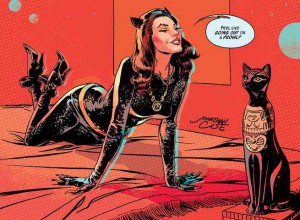
Her incarnations beyond the paneled pages of comic books has been particularly interesting too, with everyone from Eartha Kitt to Halle Berry (we must try to forget the latter, erase it from our memories) portraying her.
For my money the best Catwoman, the definitive screen version of Selena Kyle is, hands down, Michelle Pfeiffer in Tim Burton’s Batman Returns; only she and that performance could turn “meeaow” into one of the best, most memorable deliveries of a line in a decade’s worth of cinema.
Though must admit I still have a soft-spot for Julie Newmar and Lee Meriwether from the deliberately camp sixties TV show too, and actually young Camren Bicondova’s portrayal of the younger Selena Kyle in the current Gotham series is one of the best things about that show and is adding something special to the already considerable Catwoman mythology.
Frank Miller and The Dark Knight Returns
A landmark story in Batman history, The Dark Knight Returns was a 1986 four-issue mini-series written by the legendary Frank Miller, illustrated by Miller and Klaus Janson, and tells the story of a 55 year-old Bruce Wayne returning from retirement to resume crime-fighting duties but finding that he faces opposition from Gotham City’s police force and from the United States government.
This story had everything; death, rebirth, Harvey Dent/Two-Face, a particularly violent encounter with The Joker, complex scheming, Bruce Wayne’s identity being revealed, even an epic showdown between Batman and Superman.
Most of all it set a tone and a standard that marks it out as one of the most influential treatments of the Batman mythology ever and in fact one of the most influential and highly regarded comic-book storylines ever too.
Knightfall
The most defining Batman comic-book event of the 1990s, this major story arc from 1993 was the thing that drew me into Batman comics at the time. Knightfall was the event that drew me to DC Comics at a time when I was only really reading Marvel (and mostly only X-Men titles, at that).
A wearied, exhausted and burnt-out Bruce Wayne is systematically assailed and beleaguered by the steroid-enhanced lunatic Bane, all building to one decisive and harrowing showdown with the muscle-laden villain.
That final showdown between Batman and Bane in Batman #497 is one of the classic contests in the annals of DC Comics and gave me goosebumps when I first read it as a 13 year-old.

In it, we see a Batman so exhausted from having to capture escaped criminals and thugs that he can no longer adequately defend himself forced into the brutal fight that Bane has been maneuvering him into for weeks. In the event Bane brutally beats him without mercy before finally breaking Batman’s back over his knee. He literally breaks Batman and leaves Bruce Wayne a paraplegic.
And yet the most memorable image is not Bane breaking Batman’s back, but Bane throwing his broken body from a rooftop in Gotham Square to demonstrate his victory to the city. Subsequently paid homage to in Nolan’s The Dark Knight Rises movie, the cinematic interpretation didn’t come close to matching the sheer visceral shock of seeing a broken Batman in those Knightfall pages.
While I wasn’t a fan of Azrael nor really of Bane as a character either, the power of that event, particularly to a 13 year-old mind, is lasting; the DC equivalent, to me as a 13 year-old anyway, of Charles Xavier’s brutal psychic assault on Magneto in X-Men #25 which left Magneto a vegetable.
The Riddler
Another iconic villain to have come from the Dark Knight’s substantial rogues gallery, with his famous green outfit, question mark sign and his idiosyncratic riddles; probably Batman’s most engaging, entertaining foe after The Joker. Whether it’s his decades of exploits on the printed page, Frank Gorshin’s Emmy-nominated version in the sixties television show or Jim Carrey’s highly energetic portrayal in 1995’s Batman Forever (yet another role, for the record, that Robin Williams had been considered for), The Riddler seldom fails to entertain and enliven.
On the subject of Carrey’s film version, I know it has its detractors, but I’ve always liked it, it being one of the few instances (possibly the only one) where Jim Carrey’s OTT style actually works effectively in the context of the role.
I honestly find the Riddler more entertaining than the Joker in general; though I acknowledge I’m probably in the minority there.
From Batgirl to Harley Quinn: All Those Great Characters
I mean, there are so many.
So many iconic characters that have come from the Batman comic book and long since acquired legendary life of their own.
I’ve mentioned villains already; but I’m not even just talking about the array of classic bad guys spawned out of Gotham City. There are so many legendary or now-iconic non-villain characters that came out of Batman books too: think about Batgirl, Robin, Nightwing, Batwoman. All of whom are now mainstay comic book icons in their own right.

I mean, in recent years I’ve often been reading Batgirl and Batwoman comics monthly, even during times when I’m no longer reading any actual Batman titles.
And yes, again, there’s all those great villains: Poison Ivy. Harley Quinn. Bane. Scarecrow. Rais al-Ghul. Penguin. The list goes on.
No other comic book (excluding ensemble books like X-Men or Avengers) can claim to have birthed such an array of iconic characters. If we compare to other DC properties, the same certainly cannot be said for the likes of Superman comics or Wonder Woman or The Flash or Green Lantern, etc.
The more I think about it, the more I realise that this – this pantheon of characters – is what I’m most grateful to Batman comics for.
Batman: The Animated Series
Originally airing on the Fox Network from September 1992 to September 1995, Batman: The Animated Series has been frequently ranked as one of the finest animated series ever made for television, with its mature writing, high quality of voice acting, its artistic values and even its sophisticated soundtrack.
The Warner Bros show is most identifiable by its distinctive “dark Deco” visual style modelled on the film-noir artwork of producer Eric Radomski. It remains probably the definitive incarnation of Batman on the small screen.

It also had a very high caliber of contributions from voice actors, including such notables as Brock Peters, Adam West, Mark Hamill, Kate Mulgrew, Roddy McDowell, Michael Ansara, David Warner, Ron Perlman, Michael York, Helen Slater, among others.
The series also spawned three feature-length productions, including the highly enjoyable Batman: Mask of the Phantasm, originally intended as a direct-to-video release but in fact upgraded to a full theatrical release in 1993.
The Joker
The most famous of the Dark Knight’s many adversaries and the villain most associated with Batman in the popular mind, The Joker in all his various forms – comic-book, cinematic, cartoon – has been one of the great creations of the broader comic-book medium itself, let alone of the Batman franchise. Endlessly fascinating, The Joker has become much more than a mere comic-book “bad guy”, but an engaging psychological study, a genuinely unsettling figure (not always the case with comic-book villains), and without doubt one of the most popular fictional characters in our culture.
I actually feel like The Joker is somewhat overrated, in terms of there being better villains (The Ridder and Poison Ivy, for example); but I can’t pretend the character hasn’t had a massive impact. Now frequently voted the greatest villain in various comic and film polls (often even beating Darth Vader), I don’t think The Joker has ever not been an engaging presence, whether it’s in comic-book form, in the pages of the legendary The Killing Joke, or in animated form voiced by Mark Hamill, or on a cinema screen portrayed by Jack Nicholson or by Heath Ledger, the latter being now pretty much the definitive version of the character in many people’s minds. I still even find Cesar Romero’s 1960s take on the character from the Adam West TV show perfectly watchable too.
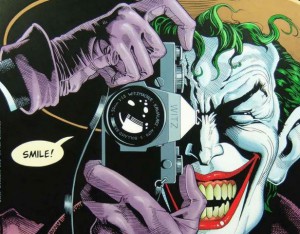
The Joker may just be the definitive villain in the contemporary landscape; unlike, say, Darth Vader who is a character of fantastical mythology and the subject of an almost operatic fallen hero motif, The Joker is simply damaged; damaged beyond repair, a product of his life experiences, no doubt, but one without scope for redemption, one who is remorseless and psychopathic.
He also seems like someone who could easily exist – and probably has, albeit minus the make-up and the witty repertoire – in real life. And that adds to his power to frighten and provoke.
One of the great ‘what ifs’ of cinema is that the late Robin Williams was seriously in contention for the role of The Joker in both Tim Burton’s Batman and Christopher Nolan’s The Dark Knight; imagine that.
I’m also going to include The Killing Joke in this entry: the one-shot graphic novel written by the legendary (I need to stop using that word, but I can’t help it – it’s valid) Alan Moore (V For Vendetta, Watchmen, and much else) and drawn by Brian Bolland, published by DC in 1988.
Widely considered one of the best comic-book stories ever published, and by many as the best Batman story ever printed, the story is most famous for providing the definitive origin story for The Joker, painting him in the past as a well-meaning family man and a failed comedian who suffers “one bad day” that ends driving him insane.
Simply a must-read for any comic-book fan, let alone any Batman fan.
Nolan’s Batman Trilogy
As different from Tim Burton’s interpretation of the Batman world as Burton’s was from the camp sixties show, they’re very good films, there’s no question. Some might quibble with Bruce Wayne’s ‘ninja training’ in Batman Begins being unnecessary add-on, but I’ve never been overly bothered with that.
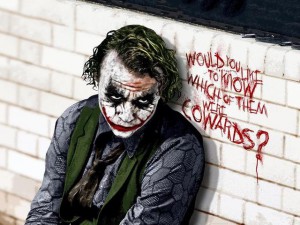
With all three films done and dusted, it’s film two, The Dark Knight, that stands out as the best of the bunch for most people, in no small part on account of the late Heath Ledger’s mesmerizing, unforgettable portrayal of The Joker. That specific performance, it has to be said, tends to raise The Dark Knight substantially above what it’s ‘true’ quality level might’ve been without it; I’ve never been massively sold on Christian Bale’s overly macho, silly-voiced Batman, but admittedly I might be in a minority on that.
Can’t quibble with Gary Oldman as Comissioner Gordon, however; can’t quibble with Gary Oldman as anything, really. And Tom Hardy’s Bane in The Dark Knight Rises has his charms (charms is the wrong word, but I’m tired so it’ll have to do).
In general Nolan’s take on the Batman mythology is much more aggressive, much more adult. That was necessary in order to get as far away from the silly cartoonery of the third and fourth Batman films from the nineties as possible. Given Burton’s highly idiosyncratic films and Nolan’s singular tone for his trilogy, it will be interesting to see what the style of future Batman incarnations (of which there will certainly be more – no one lets things rest anymore in big-budget filmmaking) is in the cinema and whether it matches up.
“A Death in the Family”
Another famous Batman story arc, published in the late 1980s, and that gave fans, among other things, the ability to influence the story through voting on the outcome with a 900 number; a ploy that worked great as a gimmick to increase interest via participation, though it somewhat guts the project artistically speaking.
Spanning Batman #426-429, the story was written by the legendary (ok, I’ll stop using that word) – by the comic world veteran – Jim Starlin. It’s a story that’s difficult to overlook, particularly for the event of The Joker brutally beating Robin to death with a crowbar (an element adapted in the terrific Batman: Under the Red Hood animated film, though the film does its own thing beyond that initial point); “a bit messy” he remarks, leaving the Dark Knight’s sidekick in a puddle of blood.
Beyond that, Starlin’s story also takes on a number of relevant contemporary (both then and now, funnily enough) social and political issues such as the Arab-Israeli conflict, the Iran/Contra affair, the corruption in rogue states, the civil war in Lebanon, the famine in Ethiopia, the smuggling of illegal nuclear materials, and even a guest appearance by the Ayatollah Khomeini.
And, um, the Joker being appointed Iran’s UN ambassador. Okay.
Fair to say it’s a story as famous for its major misjudgements than it is for its qualities, particularly its almost casually wrongheaded treatment of Iran, the story referring to “Persian” as the language of Lebanon and Arabic as that of Iran, among other things.
It’s nevertheless a must-read for Batman fans and comic-book aficionados, if not by any means a thing of perfection.
Of course some fans might contest this 10-list, citing their own preferences; a rich 75-year legacy almost guarantees that diversity of opinion. Anyhow, here’s to another 75 years of the Dark Knight and his dark, engaging world.
